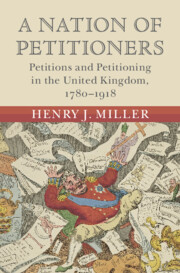Book contents
- A Nation of Petitioners
- Modern British Histories
- A Nation of Petitioners
- Copyright page
- Dedication
- Contents
- Figures
- Tables
- Acknowledgements
- Abbreviations
- Introduction
- Part I Petitions
- Part II Petitioners
- Part III Petitioning
- 7 The Practice of Petitioning
- 8 Mass Petitioning
- 9 Petitioning and Representation
- 10 Petitioning and Political Culture in an Age of Democratisation
- Conclusion
- Select Bibliography
- Index
9 - Petitioning and Representation
from Part III - Petitioning
Published online by Cambridge University Press: 02 February 2023
- A Nation of Petitioners
- Modern British Histories
- A Nation of Petitioners
- Copyright page
- Dedication
- Contents
- Figures
- Tables
- Acknowledgements
- Abbreviations
- Introduction
- Part I Petitions
- Part II Petitioners
- Part III Petitioning
- 7 The Practice of Petitioning
- 8 Mass Petitioning
- 9 Petitioning and Representation
- 10 Petitioning and Political Culture in an Age of Democratisation
- Conclusion
- Select Bibliography
- Index
Summary
Nineteenth-century MPs spent a significant proportion of their time presenting petitions and corresponding with petitioners. Petitioning and the interactions between petitioners and parliamentarians was an important component of how representation worked in practice. This chapter first examines the shift in how parliamentarians conceived petitions from an eighteenth-century system of ‘virtual representation’ to embodying aggregated popular opinion. The chapter then examines petitioning and the practice of representation. While not everyone had the right to vote, parliamentarians believed that all subjects had the right to be represented through the presentation of their petitions. The correspondence between MPs and petitioners provided a forum to negotiate the meaning of representation. Parliamentarians sought to uphold their independence in the face of petitioners demands to present and support their requests. Finally, the presentation of petitioning was a mechanism for geographic but also issue-based representation. Overall, the interaction between parliamentarians and petitioners provides new insights into the shifting relationship between politicians and the people. More broadly, it focuses attention away from theories of representation and electoral or formal representation to a wider concept of the culture of representation within a given polity.
Keywords
- Type
- Chapter
- Information
- A Nation of PetitionersPetitions and Petitioning in the United Kingdom, 1780–1918, pp. 229 - 252Publisher: Cambridge University PressPrint publication year: 2023



